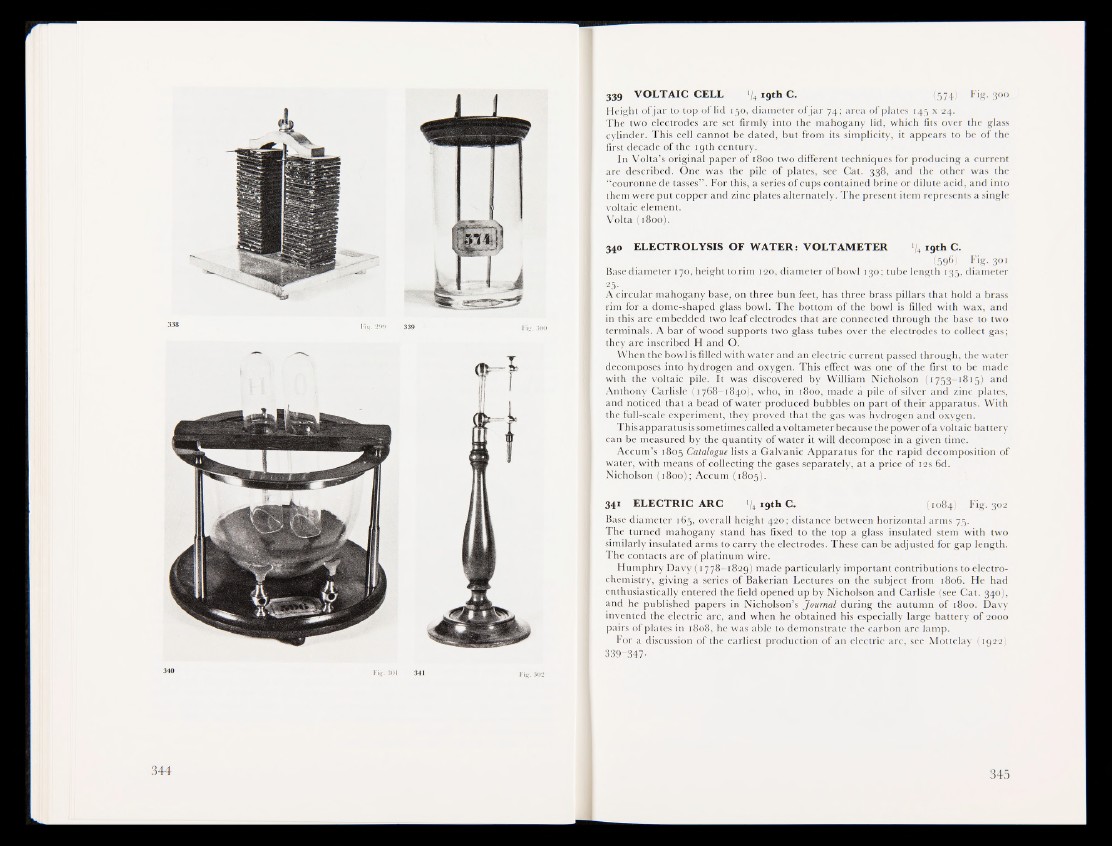
339 VOLTAIC CELL '/4 19th C. (574) Fig. 300
Height ofjar to top of lid 150, diameter ofjar 74; area of plates 145 x 24.
The two electrodes are set firmly into the mahogany fid, which fits over the glass
cylinder. This cell cannot be dated, but from its simplicity, it appears to be of the
first decade of the 19th century.
In Volta’s original paper of 1800 two different techniques for producing a current
are described. One was the pile of plates, see Cat. 338, and the other was the
“couronne de tasses” . For this, a series of cups contained brine or dilute acid, and into
them were put copper and zinc plates alternately. The present item represents a single
voltaic element.
Volta (i8oo)^B
340 ELECTROLYSIS OF WATER: VOLTAMETER */4 19th C.
(596) Fig- 301
Basse diameter 170, height torim 120, diameter of bowl 130; tube length 135, diameter
25-
A circular mahogany base, on three bun feet, has three brass pillars that hold a brass
rim for a dome-shaped glass bowl. The bottom of the bowl is filled with wax, and
in this are embedded two leaf electrodes that are connected through the base to two
terminals. A bar of wood supports two glass tubes over the electrodes to collect gas ;
they are inscribed H and O.
When the fipwl is filled with water and an electric current passed through, the water
decomposes into hydrogen and oxygen. This effect was one of the first to be made
with the voltaic pile. It was discovered by William Nicholson (1753-1815) and
Anthony Carlisle (1768—1840), who, in 1800, made a pile of silver and zinc plates,
and noticed that a bead of water produced bubbles on part of their apparatus. With
the full-scale experiment, they proved that the gas was hvdrogen and oxygen.
This apparatus is sometimes called a voltameter because the power of a voltaic battery
can be measured by the quantity of water it will decompose in a given time.
Accum’s 180)5 Catalogue fists a Galvanic Apparatus for the rapid decomposition of
water, with means of collecting the gases separately, at a price of 12s 6d.
NichRon (1800); Accum (1805).
341 ELECTRIC ARC */4 19th C. (1084) Fig. 302
Base diameter 165, overall height 420; distance between horizontal arms 75.
The turned mahogany stand has fixed to the top a glass insulated stem with two
similarly insulated arms to carry the electrodes. These can be adjusted for gap length.
The contacts are of platinum wire.
Humphry Davy (1778-1829) made particularly important contributions to electrochemistry,
giving a series of Bakerian Lectures on the subject from 1806. He had
enthusiastically entered the field opened up by Nicholson and Carlisle (see Cat. 340),
and he published papers in Nicholson’s Journal during the autumn of 1800. Davy
invented the electric arc, and when he obtained his especially large battery of 2000
pairs of plates in 1808, he was able to demonstrate the carbon arc lamp.
For a discussion of the earliest production of an electric arc, see Mottelay (1922)
339- 347-